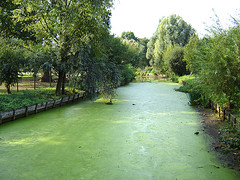 There are many environmental problems caused by human but not widely known. One of them is eutrophication. This phenomenon cannot be entirely characterised as water pollution, as it mostly describes the process of too many plants growing in lakes, rivers and sometimes in the sea.
There are many environmental problems caused by human but not widely known. One of them is eutrophication. This phenomenon cannot be entirely characterised as water pollution, as it mostly describes the process of too many plants growing in lakes, rivers and sometimes in the sea.
When household and industrial wastes are disposed into the water, they increase the quantity of germs in it. Germs threaten the health of the organisms living in the water, drinking it or feeding on organisms that live in it. Moreover, huge quantities of nitric and phosphoric salts enter the ecosystem. Phytoplankton, the tiniest sea organisms that can photosynthesize and depend highly on those salts, start to grow in population at top speed, consuming oxygen. As a result, zooplankton which feeds on phytoplankton starts to increase in numbers, again consuming oxygen and producing carbon dioxide.
After some time, during which those small organisms continue to consume oxygen and produce larger amounts of carbon dioxide, there is not enough oxygen to sustain bigger organisms, like fish, who actually die of suffocation.
Lakes are the most usual ecosystems harmed by eutrophication. Oxygen cannot be easily diminished in the sea, and the movement of the water in rivers transfer the salts else where. The most common sign of eutrophication is the waters having a deep green colour. And as human wastes increase, ecosystems become more fragile and their living organisms more vulnerable to suffocation.
Consequently, one of our first priorities, as far as those ecosystems is concerned, is to find alternative ways of removing our industrial and household waste, so that it doesn't end up in the water. The top priority, needless to say, is to reduce those wastes.
Recommended Comments
Join the conversation
You can post now and register later. If you have an account, sign in now to post with your account.